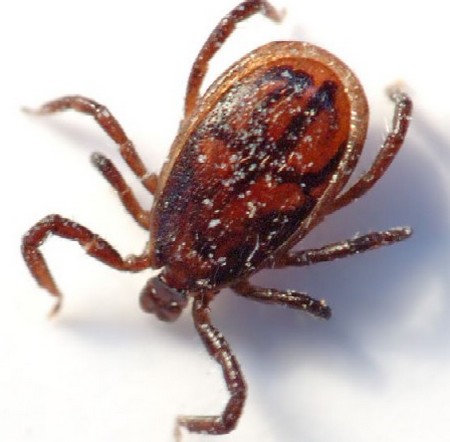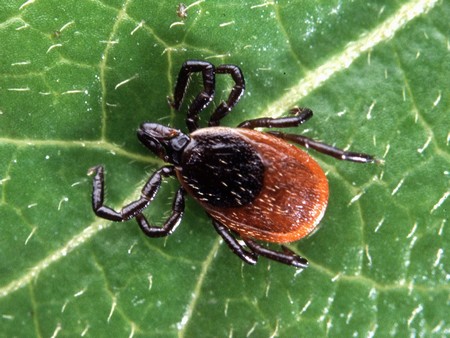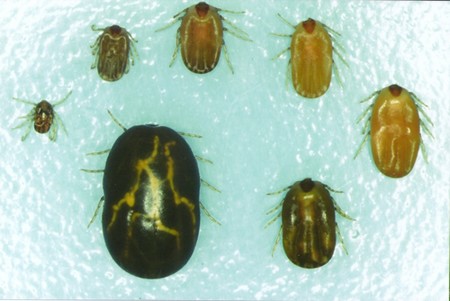For many of you ticks are nothing more than insects. However, these are actually blood-sucking living being that fall under arachnids (member of spider family). Ticks are usually associated with spiders and scorpions. They are a four legged creature with two simple eyes. Broadly, ticks are classified into two major categories, i.e. soft ticks and hard ticks.
The ticks having tough, leathery skin are known as soft ticks. Caves and nests are their favorite dwelling places. Soft ticks lived on bats, birds, and ground nesting animals. However, humans are also come across these ticks in the situations where they visit a cave or far-off campsites. The development of soft ticks depends on a series of molts, especially in nymphal developmental stage. You can easily see the mouth part of the soft ticks from the upper side carrying bacteria which is responsible for Lyme disease in dogs and humans, ehrlichiosis, tick-borne relapsing fever, tularemia, Rocky Mountain spotted fever and babesiosis.
Hard ticks have a hard shield on the back and mouth with parts protruded from the head. The hard ticks lived on the blood of wild and domestic animals, mammals and humans. Each and every blood meal helps them move into next stage of their life cycle. The life cycle comprises of a larval, nymphal and adult stage.
Different Types of Ticks
Following are given some of the different types of ticks which are accountable for several human and animal diseases. In United States alone over 200 different types of ticks are found. Let us have a brief introduction of some of the types of ticks.
Dermacentor variabilis
Commonly found in the Eastern United States, are often referred to as American dog ticks. An average adult tick can grow up to 3/16″ long. After feeding, this size can go up to the length of 1/2 inch. The markings find on their shields are varied in nature. The young larvae and nymph of the ticks lived on mice while the adult ticks enjoy the dogs and other large animals for their feeding. Normally, a female tick laid around 6,500 eggs which hatch in just two months of time. The major diseases caused by this type of tick include the Rocky Mountain spotted fever and tick paralysis.
Rhipicephalus sanguineus
Also called brown dog tick, is found in reddish brown color. These ticks can grow up to the size of 1/8 inch. These ticks usually infect the dogs and commonly found on their bodies. These are basically known as indoor ticks which spend much of their life inside the houses and dog kennels. The larvae of reddish brown tick as well as adults enjoy feeding on dog’s blood. These care commonly found in Arizona.
Amblyomma maculatum
Prevalent in the Southeastern States of America, usually referred to as Gulf cost tick. These ticks normally grow up to the size of 3/32 inch and are considered as small ticks. The young larvae and nymph feeds on ground-nesting birds whereas the adult ticks stick to the ears of the deer and cattle. These are known for causing a fatal disease called Lyme disease spirochetes. They are not restricted to the animals as they can often get on the human skins and bite them, which is quite painful. This small creature uses its feet to sense the presence of the host. It waves its legs in the air and sense the vibration or carbon dioxide from the nearby host. If you or your dog comes across this tick, you can use kerosene to remove it from the dog’s fur or from your skin.
Amblyomma americanum
Commonly known as lone star tick, they feed on the human blood. Unlike other types, the mouth parts for this tick are quite large that enter deep into the human skin and cause pus sores. They usually stop the growth of the particular parts on the skin where they dwell. A silvery mark on the dorsal shield helps recognize the female tick.
Ixodes scapularis
This type of ticks is prevalent in Southeastern regions of United States. You can find them easily alongside the roadways, trails and paths. These are often referred to as black legged tick because of having dark brown or dark black legs. The overall body color is dark reddish-brown.
Ornithodoros turicata
This tick is a member of soft tick genus. These are often called relapsing fever tick because of their tendency to spread relapsing fever in humans. They reside in the dwelling-place of mouse and rat and usually infest rodents. You cannot see the mouth of these ticks from above.
Dermacentor albipictus
The other names given to this tick are moose ticks, elk ticks and winter ticks. These are so called because they mostly infest the moose, caribou, cattle and elk. The distinctive feature of these ticks is that they remain stick to their host for its entire life. The moose with missing patches of fur on its body shows that it is infested by the ticks. However, they don’t cause any disease to their host but the excessive number of ticks can cause death of the animals because of hypothermia and emaciation. They don’t cause any disease to humans.
Ixodes ricinus
They belong to the hard tick genus and cause severe diseases like meningoencephalitis and Lyme disease in humans. The other names for these ticks are castor bean tick and sheep tick. They infest the sheep and cause louping illness in them.
Boophilus microplus
Also known as the southern cattle tick, infest the sheep, horses, goats and cattle. It is accountable for transferring fatal diseases to the animal bodies which can cause pathogens that eventually result in the death of the animals.
Argas radiatus Raillet
These are common fowl ticks which usually infest the poultry houses. Other name given to it is blue hug. They have the tendency to spread disease in humans apart from being destructive for chickens.
Above mentioned are some of the common types of ticks which are equally harmful for both humans and animals. An interesting fact about these ticks suggests that they can stay alive without food or water for almost 200 days. The average life span of ticks varies from species to species and ranges from 2 months to 2 years. It is recommended to take necessary precautionary measures to avoid ticks. If you or your pet is infested by ticks better consult the doctor or visit the veterinarian respectively.



